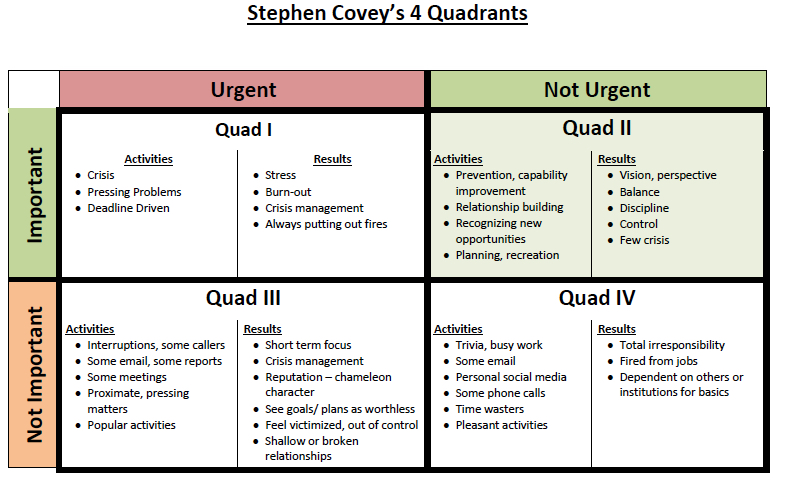
But there are always improvements to be had by spending more time in Quadrant 2 - perhaps carving out time to build relationships, put in systems and processes and delegating. You may also find the "Big Rocks" Coaching Exercise helpful where they identify and focus on completing their "big rocks" first before working on the pebbles and sand which otherwise fill up their lives.Ĭoaching Tip: If your client is in a line management or service based role, they will spend more time in this quadrant than a project manager. Your clients may need help identifying and clarifying priorities - and to brainstorm ways to schedule chunks of time for these important tasks. How we feel: When we spend a lot of time in this quadrant we become stressed and burned out.Īction: Minimise the time spent in this quadrant by prioritizing, planning and delegating ie.

This can be anything from an overdue project or report to customer complaints, a severe bottleneck or broken business process right through to a burst pipe or a health issue like a toothache that hasn't been dealt with! What: Tasks that fall into this quadrant include deadlines, urgent meetings, pressing problems, crises and fire-fighting. Quadrant 1 - Crises or "Important AND Urgent" Tasks So, let's take a more detailed look at the individual Urgent Important Matrix quadrants:

Quadrant 2 - Goals and Planning - NON-URGENT and IMPORTANT.Quadrant 1 - Crises - URGENT and IMPORTANT.Using a simple grid, it defines tasks according to their importance and urgency: He is quoted as saying, "What is important is seldom urgent and what is urgent is seldom important." It was Dr Stephen Covey (of "The 7 Habits of Highly Effective People" fame) who took these concepts mainstream, calling it The Urgent Important Matrix in his famous book. Well, Former US President Eisenhower used this so-called "Eisenhower Principle" to organize his tasks. Wouldn't it be nice to ride the wave, rather than the other way around? It's also a great model to share with youth and anyone who is disorganized to help them be more focused - and it's a compelling experiential tool to use in a workshop or seminar. It's great for a wide spectrum of coaches from career, executive and business coaching to life and even spiritual coaching.

The Urgent Important Matrix is a powerful productivity and time management tool to help people manage their time more effectively.


 0 kommentar(er)
0 kommentar(er)
